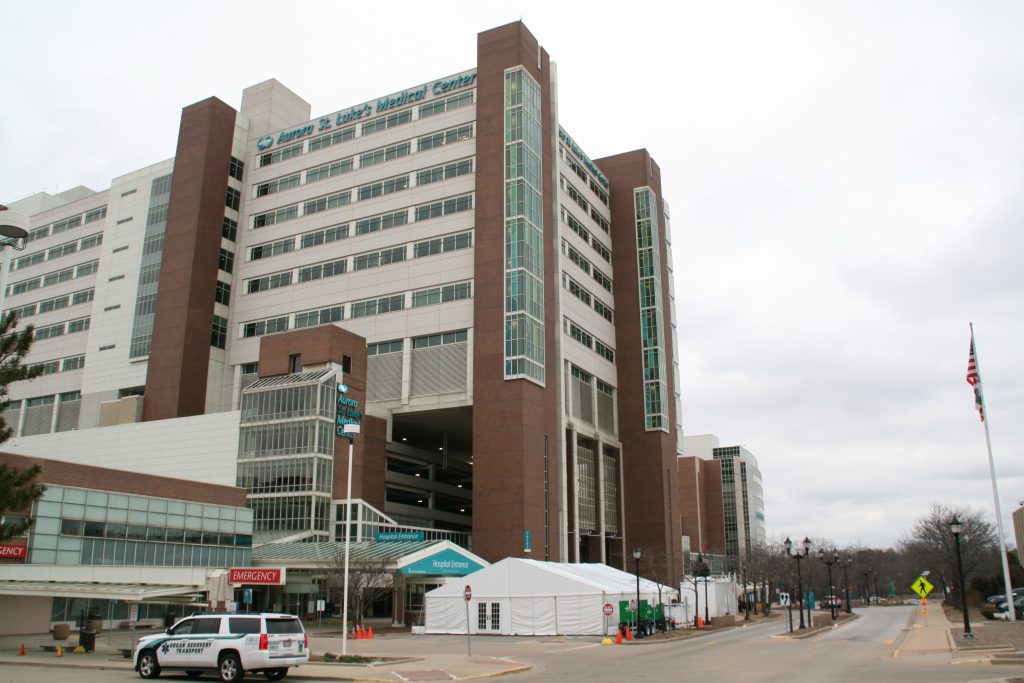Officials Want Physicians To Request More COVID-19 Tests
Testing capacity is more than triple what's being requested. Officials want doctors to test more people.

Triage tent at St. Luke’s. Photo by Jeramey Jannene.
Despite the fact COVID-19 testing capacity has doubled across Wisconsin in the past week, the number of tests performed has not.
State and local officials would like to see that change as part of a multi-pronged strategy to combat the disease.
“We are certainly working hard to make sure that providers understand that there is capacity in the system,” said Wisconsin Department of Health Services Secretary-designee Andrea Palm on Thursday during a media briefing. DHS announced a loosening of restrictions last week. Individuals previously needed to show signs of a respiratory illness and require hospitalization or work in healthcare to get priority access to a test. Now any individual believed to have the disease and for whom a diagnosis would be beneficial can be tested. “We are not living in a world where we need to be quite so restrictive,” said Palm.
Milwaukee Mayor Tom Barrett would welcome more clustered testing in Milwaukee. He noted that there are census tracts on the north side of the city that have more than 30 cases, a total larger than most Wisconsin counties. He said targeted testing in those areas could provide more data and allow public health officials to isolate those with the disease.
“The more widespread we can have that testing, that isolation, that contact tracing, the quicker we will be able to lift this order,” said Barrett.
Barrett and Palm’s push is supported by Greenfield Health Officer Darren Rausch. “To do the work of controlling COVID well, the next step we need to take is to really increase testing,” said the public health expert during a Milwaukee County press briefing.
Dr. Ryan Westergaard, Chief Medical Officer at the DHS Bureau of Communicable Diseases,” said there are other reasons more people should be tested for COVID-19. He said the seasonal spread of influenza, another respiratory illness, is fading. “Mild patients in outpatient settings can now be tested,” said Westergaard. He said he expects more tests to be done in the coming weeks.
An average of 1,505 people per day were tested in Wisconsin over the past week, Palm said, but as of Thursday, the state has the capacity to test 7,578 samples per day.
If you think stories like this are important, become a member of Urban Milwaukee and help support real, independent journalism. Plus you get some cool added benefits.
More about the Coronavirus Pandemic
- Governors Tony Evers, JB Pritzker, Tim Walz, and Gretchen Whitmer Issue a Joint Statement Concerning Reports that Donald Trump Gave Russian Dictator Putin American COVID-19 Supplies - Gov. Tony Evers - Oct 11th, 2024
- MHD Release: Milwaukee Health Department Launches COVID-19 Wastewater Testing Dashboard - City of Milwaukee Health Department - Jan 23rd, 2024
- Milwaukee County Announces New Policies Related to COVID-19 Pandemic - David Crowley - May 9th, 2023
- DHS Details End of Emergency COVID-19 Response - Wisconsin Department of Health Services - Apr 26th, 2023
- Milwaukee Health Department Announces Upcoming Changes to COVID-19 Services - City of Milwaukee Health Department - Mar 17th, 2023
- Fitzgerald Applauds Passage of COVID-19 Origin Act - U.S. Rep. Scott Fitzgerald - Mar 10th, 2023
- DHS Expands Free COVID-19 Testing Program - Wisconsin Department of Health Services - Feb 10th, 2023
- MKE County: COVID-19 Hospitalizations Rising - Graham Kilmer - Jan 16th, 2023
- Not Enough Getting Bivalent Booster Shots, State Health Officials Warn - Gaby Vinick - Dec 26th, 2022
- Nearly All Wisconsinites Age 6 Months and Older Now Eligible for Updated COVID-19 Vaccine - Wisconsin Department of Health Services - Dec 15th, 2022
Read more about Coronavirus Pandemic here


















Keep in mind that contract tracing needs to accompany the testing in order to suppress the infections. Mayor’s Barrett’s idea of prioritizing clusters makes a lot of sense to me.
I also wonder if prioritizing school age children for testing and contact tracing makes sense. Asymptomatic and pre-symptomatic persons with the infection shed a lot of the virus. Many children with the infection tend to be asymptomatic. An infectious disease expert at University of Pittsburgh estimated that asymptomatic infection is “occurring in 10% to 30%” of children’s cases.
And at least many of children’s contacts are relatively easy to identify–siblings, parents, playmates, other family caregivers. So it seems there could be a positive multiplier effect, in terms of identifying cases, from a focus on school age children.
If this approach is pursued, the community needs to ensure that appropriate care and monitoring is available for families and households where infection is identified.